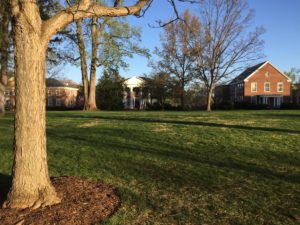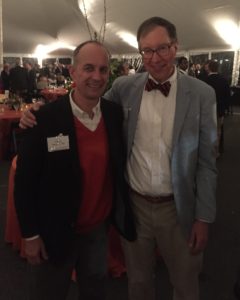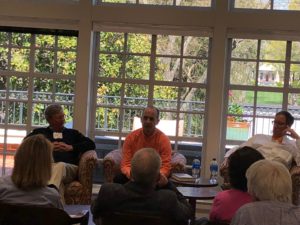
In April of 2018, I returned to Woodberry Forest School in Virginia for my thirtieth high-school reunion. I had some of the same feelings that I assume most people have when attending such a reunion: excitement, nostalgia, trepidation. My classmates had seen some of my best and worst moments in life; they literally saw me grow up from an awkward, metal-mouthed kid to a somewhat less-awkward young man. On top of that, we all lived with each other for nine months out of the year. Put 350 teenaged boys on a hill in rural Virginia and you’ll understand why Lord of the Flies could happen.
However, I was apprehensive about this particular reunion for a reason most people don’t have. The previous fall, I had published a novel set in a boarding school with more than a passing resemblance to Woodberry, with characters who bore the first or last names of some of my own classmates. Woodberry Forest had been very supportive of me and Shadow of the Lions, writing a nice article for their website and inviting me to participate in a panel discussion during my reunion visit. I had been contacted by classmates who praised the book and congratulated me.

But actually returning to Woodberry felt a bit like returning to the scene of a crime. The events in Shadow of the Lions are almost entirely fictionalized; I know of no crimes that took place during my time at Woodberry, and my roommate never disappeared as Fritz Davenport does in my novel. My novel is not an exposé of Woodberry. But it does draw on my experience of living and going to school at Woodberry for four of the most formative years of my life. How would my classmates and former teachers react?
Amazingly, it turned out.
The class of 1988 had a good turnout. The Friday we arrived, there was a reception for alumni under a tent behind the headmaster’s house. I greeted and was greeted by people I hadn’t seen since graduation. Everyone seemed to know about the novel, in part because my friend and Woodberry roommate for three years, Matthew Middelthon, had proudly told everyone about it. Everyone shook my hand and smiled and clapped me on the shoulder and said they’d loved the book or they hadn’t read it yet but planned to.

The night was cool but clear, and I stood under the tent with a beer in my hand, looking at the strung lights and knots of people at the hors-d’oeuvres table or the bar. I was struck then by the oddest sense of déjà-vu: near the end of Shadow of the Lions, the protagonist Matthias Glass attends his tenth-year reunion at Blackburne, under a tent strung with lights. A classmate saw me staring around the tent and asked if I was okay. I waved an arm at the scene in front of me, trying to encompass everything, and gave him a goofy smile. “It’s just . . . this is just like a scene in my book,” I said. He grinned and clinked his beer bottle against mine.
The next day, Saturday, was pleasantly surreal. A few weeks earlier, my AP English teacher from Woodberry, Ted Blain, had e-mailed me with a special request. His fifth-form or junior students were reading Shadow of the Lions for his class, he told me, and they were about two-thirds of the way through. They were enjoying it and wanted to talk with the author and ask me some questions. The problem was that they did not meet as a class on Saturdays, but Mr. Blain had worked out a half-hour block of time when the majority of his students would be free. Would that work?
Let me get this straight, I thought. My former English teacher, a role model for me in my own career as a high-school teacher, is teaching my novel to his current students, and they’d like to meet with me to talk about the book and ask me some questions. Yeah, I think I could swing that. That’s not what I wrote Mr. Blain in response–I basically said yes, thank you, that would be wonderful–but I think he understood.

So I met with several junior boys at 11am on Saturday morning in my old English classroom, with my former English teacher looking on. My friend Matthew insisted on coming and sat in the corner. The half hour stretched to forty-five minutes or so, and it was delightful. The students were polite and insightful and asked all kinds of good questions, and I can only hope my answers didn’t sound canned or pompous.
That afternoon, Woodberry scheduled an author round table discussion with myself; Jon Buchan ’68, author of Code of the Forest; and Mr. Blain, who had written two murder mysteries. After having gone on the road to support my novel, I knew that any sort of public reading or discussion was a “fingers-crossed” event, where the attendance might be fifty people, or five, or two. Most of my classmates showed up, along with some of Jon’s as well and a few Woodberry staff members.

Boarding school was not easy. I did relatively well in school and enjoyed the academic challenge, most of the time, and I made some good lifelong friends. But I was a dorky teenager and not very good at the give-and-take verbal banter that is the daily bread-and-butter of teenage life. I was always thinking of great responses five minutes later. I was friendly with most of my fellow students, but I only had a few friends I would call close. Boarding school was an amazing and formative experience, but it was not always pleasant, and I cried my share of frustrated tears, wondering why some of my classmates seemed to tease me mercilessly. Looking back on those years, I can see that it wasn’t much more than the usual kind of sparring that teenagers have engaged in since teenagers were invented, but at the time it just felt cruel.

Sitting at that author round table and looking out at my classmates, who all had other things they could have been doing on a sunny Saturday afternoon at their high school reunion, I felt like, after a long absence, I had just come home. They asked questions and clapped and cheered, and then they brought me copies of my book to sign for them. One classmate said he loved the Easter eggs I had sprinkled throughout the novel, referencing people and places my classmates all recognized. Another asked if he was in the book, and if so, what happened to him. People often talk about the bonds formed among boarding school classmates, and all I can say is that, for me, those bonds are real.
 But my favorite question of the afternoon was from a classmate I hadn’t seen for thirty years.
But my favorite question of the afternoon was from a classmate I hadn’t seen for thirty years.
In Shadow of the Lions, the opening scene takes place at the front entrance to Blackburne, where the drive is flanked by two brick columns, each topped by a stone lion, the school mascot. Those stone lions are referenced throughout the novel.
This classmate of mine plunked down a copy of Shadow of the Lions for me to sign. As I started to sign it for him, he said, “Hey, Swanny, I have a question. Where are the lions?”
I looked up at him. “What do you mean?”
“The lions,” he said. “The stone lions, you know? I’ve been looking for them.”
“The ones in my book?”
“Yeah,” he said. “What happened to them? Did they take them out or what?”
Finally I understood. He had been looking around Woodberry’s campus for the stone lions. “Dude, I made them up,” I said. “We’re the Woodberry Tigers. There aren’t any lions.”
He looked surprised, then irritated, and then he burst into laughter. “That’s a good one,” he said, like I’d just played a trick on him and he admired how I’d done it.
That might be the best review my novel has received.




